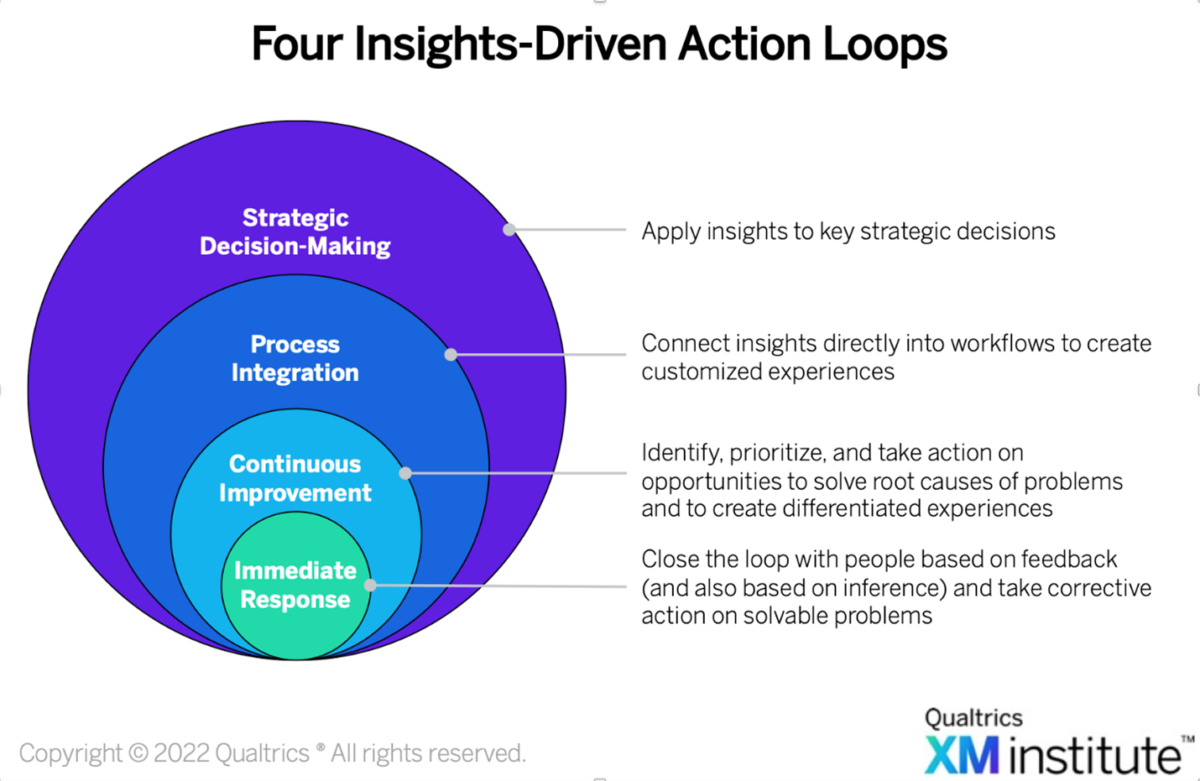
Problem? Solved. This is a favorite asked-and-answered response for businesses. Issues are inevitable. They cost time, money, and often create poor customer experiences. Resolving as many as possible, as quickly as possible, is the go-to approach for many organizations.
But what if we started to think of problems as strategic opportunities?
When reframed from “challenge to solve” into “chance to change,” problems create a valuable time to capture diverse data and put new processes or systems in place. The higher-level thinking makes the business better long-term—and contributes to its vision and goals for the future.
This is strategic decision-making and offers a powerful way to drive business performance through experience management (XM).
What Is Strategic Decision-Making?
Strategic decision-making takes insights influencing an organization’s existing operations and applies them to decisions about future activities and areas of investment. The process involves gathering information from key stakeholders, which may include:
- Customers
- Employees
- Investors
- Suppliers
- Trade partners
- Communities
- Government entities
Trends, patterns, and improvement opportunities emerge from the aggregated data. The findings aid decision-makers in setting the company’s direction, vision, and goals. The insights then become actionable steps uniquely applicable to each area of an organization influencing the customer experience (CX).
Strategic decision-making is a key skill connected to the RESPOND competency of the XM Operating Framework. The competency focuses on building mechanisms designed for continuous action from insights.
Responding to information follows what the XM Institute calls four “action loops.” Each grows in its level of influence over systemic, long-term changes that benefit both the customer and company. The loops start with simply solving a problem and progress to strategies for organizational improvement.

Strategic Decision-Making in Action
Transitioning from problem-solver mode to a strategic decision-making mentality takes work. Often organizations get stuck playing Whac-A-Mole with daily challenges and do not use the information for continuous improvement. Working an issue through the action loops ensures insights influence more than just existing operations.
Let’s work a common contact center issue: increasing call volumes and decreasing customer satisfaction scores.
- Immediate Response – The data collected indicates the center is understaffed. The quickest fix for solving the problem is hiring new team members.
- Continuous Improvement – Hiring is simply a band-aid solution, especially in today’s low unemployment, high turnover economy. Expanding the capacity of staff offers a better long-term solution, and one that aligns more closely with the organization’s budget. Investing in staff training on how to process calls more efficiently and effectively is an opportunity for continuous improvement.
- Process Integration – This loop uses insights to trigger customized workflows that prevent the problem from happening. Integrating an interactive voice response (IVR) system can lessen call volumes by automating answers to common inquiries, which protects agent time for solving more complicated issues.
- Strategic Decision-Making – A successful IVR implementation opens the door for a more comprehensive self-service strategy that integrates phone, web, and chat. The collected insights offer leaders valuable information on the strategy’s probability for success, alignment with business goals, and the return on investment.
Developing a Strategic Decision-Making Process
Strategic decision-making looks different for every organization. However, following six steps ensures the process is thoughtful, meaningful, and effective. After all, every decision should connect directly to business goals and performance. If they don’t, revisit the insights, gather more data, or start thinking bigger.
Step 1: Evaluate the challenge or opportunity
Start by assessing the situation. Research the issue to understand the nature of the problem, its causes, and the larger impact on the organization.
Step 2: Apply the lens of the organization’s strategic vision and goals
CX is not just about making people happy. The practice uses customer touchpoints to create experiences that contribute to business goals such as revenue growth, improved customer retention, cost reductions, or bigger market share. Analyze how the issue impacts organizational objectives today and in the future.
Step 3: Gather data from multiple sources
Strategic decision-making is about seeing the forest beyond the trees. Gather multiple sources of data to inform the issue. Connect the data to assess its various influences. The process forces CX leaders to look beyond simply solving the immediate issue, which often does not result in a sustainable or systemic change.
Step 4: Let the data tell its story
Approach the data with an open mind and follow where it takes you. Combining e(X)perience and (O)perational data often uncovers new challenges or root causes needing addressed. Layering in additional stakeholder data offers other valuable insights to get a full picture of the challenge or opportunity and the best next steps. The most captivating stories reveal important details that give people more to grab on to. Strategic decision-making uses data insights the same way.
Step 5: Implement changes
Let the insights influence decisions. Set experience management goals and targets for the executive team. Get their buy-in and investment for necessary resources. Then strategically introduce those XM objectives throughout the organization so everyone starts contributing.
Step 6: Institutionalize the improvements
Commit to supplying the resources and infrastructure to support the decision—from the c-suite to the front line. Develop communication, training, and accountability around the improvements. Ensure new processes become so embedded that they can survive staff turnover, leadership changes, and competing priorities to impact results long term.
Avoiding Strategic Decision-Making Pitfalls
Strategic decision-making challenges organizations because multiple hidden hazards lurk throughout the process. Beware of these common pitfalls designed to destroy strategic XM thinking:
- Using data to fit a narrative. Do not approach an issue with a solution already in mind. That creates an opportunity for confirmation bias. Data gathering becomes a cherry-picking expedition set up to affirm the existing idea or belief rather than making the best decision.
- Focusing only on the problem. Immediate action is the smallest loop for a reason. Its impact is minor compared to using the problem as a trigger for strategic organizational improvements aligned with business goals. Don’t give the most attention to the least important opportunities.
- Experiencing metrics myopia. No lack of metrics exist in customer experience. NPS, CSAT, CES, churn rate—the list goes on. Too often companies get hung up on metric scores rather than the issues driving them. Even worse, they do not connect the metrics to business goals, voiding them of value.
- Not gathering all the data. Using a single data source for strategic decision-making is like reading one chapter of a book and thinking you know the whole story. Incomplete data leads to inferior decisions.
- Suffering from analysis paralysis. There is too much of a good thing. Sometimes gathering data becomes the goal rather than using the information for action. Data does not spark improvements. Insights gleaned from the findings do.
Moving Beyond Metrics: Key CX Actions
Organizations often make the mistake of treating CX metrics as the focus of their efforts. Metrics do not improve the business. The experiences behind the data are what matters most. Companies can move beyond simply tracking metrics to making strategic decisions that move the business forward by:
- Reviewing CX insights and metrics as a criterion for making large-scale decisions.
- Assessing CX impact as part of planning and budgeting.
- Setting CX objectives aligned with the organization’s top priorities.
- Embedding CX strategies throughout every level of the organization and making everyone feel like an owner.
- Encouraging leaders to ask how business decisions will affect CX initiatives and the organization’s ability to live up to brand promises.
- Closing the loop by asking, “What have we learned? What improvements are we making? How are our efforts affecting our strategic decisions?” The answers should prompt continuous improvement and refinement.
Transform Data Into Strategic Decisions
Most companies are problem solvers. They have to be. Far fewer go the extra step of transforming issues into strategic opportunities. Making the leap from insight to action takes work, but the competitive edge gained is well worth the effort. These companies operate at a different level. They see the big picture. Every insight a brushstroke. Each decision informed stakeholders, the most important of which is the customer.